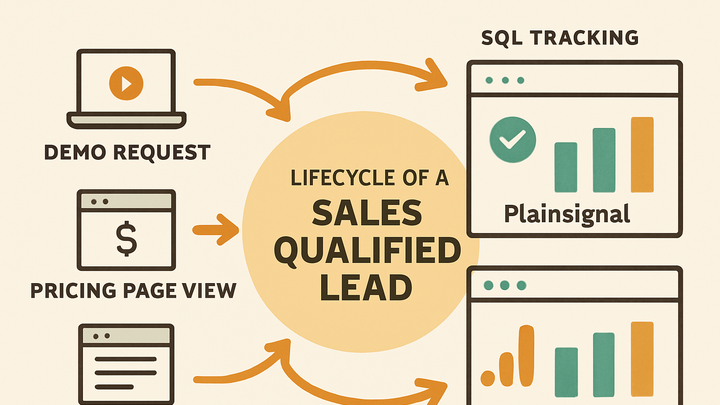Published on 2025-06-28T09:04:05Z
What is a Sales Qualified Lead (SQL)? Examples for SQL Tracking
Sales Qualified Lead (SQL) is a prospect who has been vetted by marketing and determined to be sales-ready based on specific criteria. In analytics, SQLs mark the point where a lead moves from marketing engagement to active sales follow-up. By tracking SQL events—like demo requests, pricing page views, or contact form submissions—teams can measure lead quality, optimize campaign performance, and prioritize outreach. Platforms such as PlainSignal (a cookie-free, simple analytics tool) and Google Analytics 4 (GA4) provide event-based models to capture and segment SQL interactions. Implementing SQL tracking improves pipeline velocity, forecasting accuracy, and cross-team alignment. Analyzing SQL metrics also uncovers insights into channel effectiveness and customer behavior, guiding strategic decisions to drive revenue growth.
Sales qualified lead (sql)
A Sales Qualified Lead is a prospect vetted for sales readiness, tracked as custom events in analytics tools like PlainSignal and GA4.
Understanding Sales Qualified Leads
Sales Qualified Leads (SQLs) are prospects deemed ready for direct sales engagement based on predefined behavioral and demographic criteria. They follow Marketing Qualified Leads (MQLs) in the conversion funnel and indicate higher buying intent. Recognizing SQLs ensures sales teams focus on leads most likely to convert.
-
Definition of sql
A Sales Qualified Lead is a prospect who has met both basic fit criteria (e.g., company size, industry) and demonstrated intent through key actions (e.g., demo request). Unlike MQLs, SQLs have passed a sales readiness threshold.
-
Sql vs mql
MQLs show interest and engagement but often require more nurturing. SQLs exhibit clear buying signals—such as requesting a demo or pricing details—making them prime candidates for direct sales outreach.
Importance of SQL in Analytics
Tracking SQLs in analytics platforms bridges marketing activities and sales outcomes, enabling teams to measure lead quality, optimize campaigns, and forecast revenue more accurately.
-
Aligning sales and marketing
SQL metrics create a shared definition of lead readiness, unifying objectives and improving handoff between marketing and sales teams.
-
Measuring funnel efficiency
Analyzing SQL conversion rates at each stage highlights bottlenecks and opportunities for process improvement in both marketing and sales workflows.
Identifying SQL in PlainSignal
PlainSignal offers a cookie-free event model that simplifies capturing SQL interactions without third-party cookies. You can define custom events to flag sales-ready behaviors and build segments for reporting and outreach.
-
Setting up sql events
Define custom events for key actions (e.g.,
demo_request,pricing_view) using PlainSignal’s JavaScript snippet. Each event should correspond to a clear SQL criterion.-
Example PlainSignal snippet
<link rel="preconnect" href="//eu.plainsignal.com/" crossorigin /> <script defer data-do="yourwebsitedomain.com" data-id="0GQV1xmtzQQ" data-api="//eu.plainsignal.com" src="//cdn.plainsignal.com/plainsignal-min.js"></script>
-
-
Segmenting sqls
Use PlainSignal’s segmentation interface to group users who trigger your SQL events, enabling targeted reporting and follow-up lists for the sales team.
Tracking SQL in Google Analytics 4 (GA4)
GA4’s fully event-based data model lets you capture and analyze SQL interactions across websites and apps with flexibility and precision.
-
Event tracking
Implement custom events in GA4 for SQL actions. Use gtag or Google Tag Manager to configure events like
demo_requestorpricing_viewwith relevant parameters. -
Creating audiences
Build GA4 audiences from users who fire SQL events. Leverage these audiences for deeper analysis in GA4 reports or for remarketing campaigns in Google Ads.
Implementing SQL Tracking: A Unified Example
Combining PlainSignal and GA4 allows teams to cross-validate data and leverage each tool’s strengths—cookie-free accuracy from PlainSignal and robust analysis in GA4.
-
Dual tagging approach
Embed both PlainSignal and GA4 tags on your site. Ensure events are named consistently to match SQL criteria across platforms.
-
GA4 snippet
<script async src="https://www.googletagmanager.com/gtag/js?id=GA_MEASUREMENT_ID"></script> <script> window.dataLayer = window.dataLayer || []; function gtag(){dataLayer.push(arguments);} gtag('js', new Date()); gtag('config', 'GA_MEASUREMENT_ID'); // SQL Event Example gtag('event', 'demo_request', { 'method': 'website' }); </script>
-
Best Practices for SQL Tracking
Accurate SQL tracking requires clear definitions, consistent naming conventions, and regular validation to maintain data integrity across tools.
-
Define clear qualification criteria
Collaborate with sales to outline exact actions and thresholds that constitute an SQL event.
-
Maintain naming consistency
Use standardized event names and parameter conventions across PlainSignal and GA4 to avoid confusion and ensure reliable reporting.
-
Regular data audits
Periodically verify that events fire correctly and segments populate as expected. Address anomalies swiftly to keep your pipeline data accurate.
